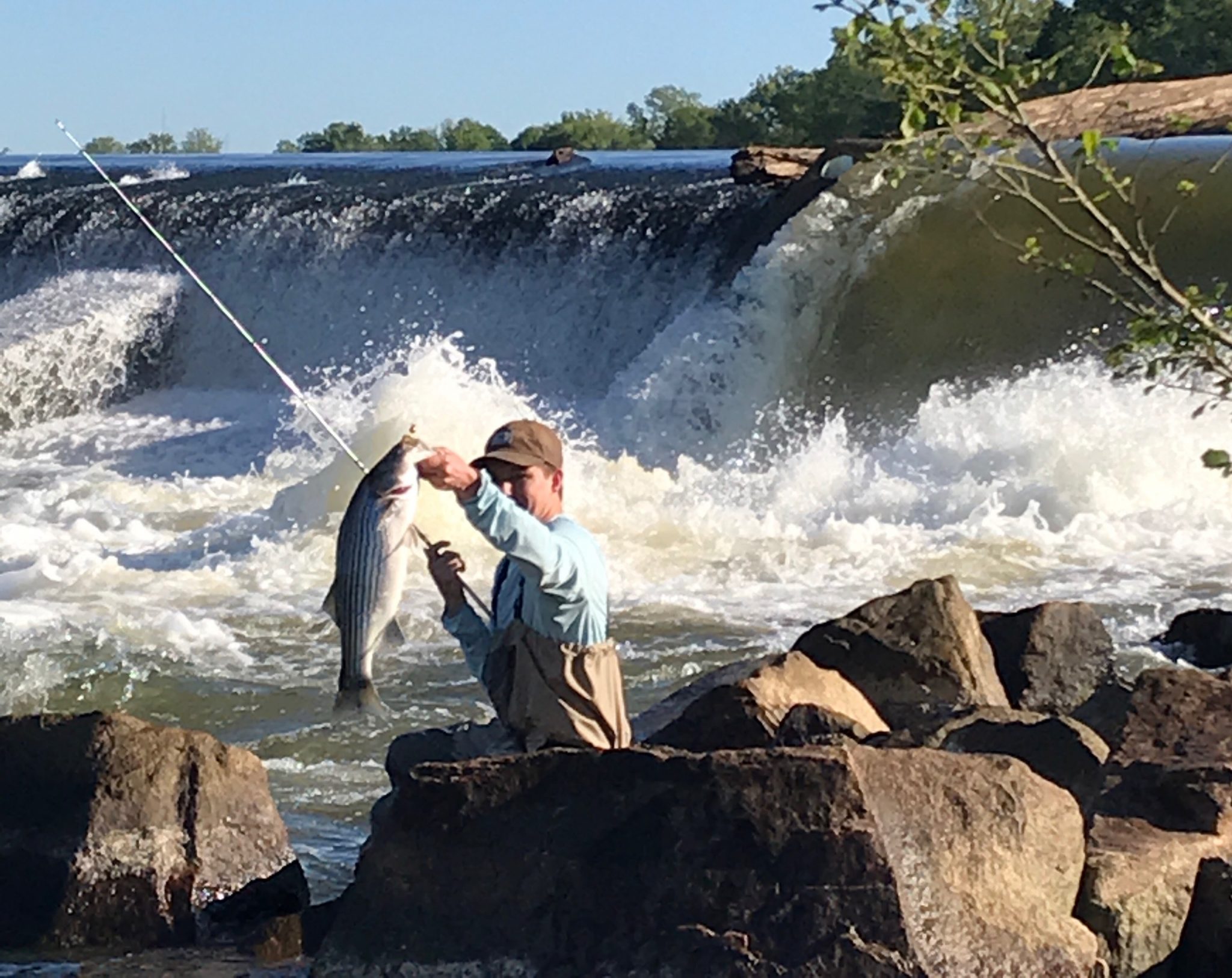

Triggered at about the same time as when the dogwoods bloom, many species of fish in South Carolina begin their spawning runs up the state’s intricate river systems. The event as a whole is so great and receives so much attention from our anglers that it reminds me of the salmon run up north. Giant carp can be seen with their paddle sized tails out of the shallow water as they pass through the rocks. Gizzard shad and herring, the primary food source to many birds and freshwater fish are also on the move up stream. Among the rush of fish swimming against the current is South Carolina’s State Fish, the Striper.
The migration takes place across many of our lakes as the fish swim up the rivers that feed these lakes. I usually focus on the fish that swim from the Santee Cooper Lakes because of their location relative to Dillon. The Santee Cooper Lakes are fed by a network of rivers including the Wateree, Broad, and Saluda Rivers which all feed into the Congaree River. Each of these rivers see the migration from the Santee Cooper System and to have a successful day is all about catching the fish at the right time and place.
Packs Landing, located on the North side of Lake Marion near the mouth of the Congaree River is the first to see the move and the reports are no secret as boats rush to catch striper in the river. Columbia sees them within a month on the Congaree and the striper swim on into the Broad and Saluda Rivers. The spawning fish move in and out rather quickly but some take up summer residence in the cold waters of the Saluda River. It is important to search USGS Current Conditions for the river of choice before planning your trip because you may arrive to find the water at an unfishable level.
We took a fleet of 3 canoes to the Congaree River on April 5th for my birthday and I was the only one to catch a small striper. Dawson Jordan returned to the Broad River on Thursday catching 2 nice striper early in the morning but was hindered from catching more. Ryan Stephens led a group of 4 to the Broad the next day catching 2 striper himself (largest was 15 pounds) and a 30 pound carp. Others in the group caught striper, largemouth, and smallmouth bass for a tremendously successful day.

The water level that day on the Broad River was 10,000 cubic feet per second and scheduled to drop to 4,000 cubic feet per second on Saturday, April 11. I was itching to try it for myself and since I could not see Shannon, my bride to be before my wedding at 6PM, the Broad River seemed like the perfect place to spend the morning. Ryan Stephens, Dawson Jordan, and I saddled up and left Dillon at 5:15 that morning for Columbia. The ride went by fast and we were casting along the rocky river at first light. Dawson caught a 20 lb catfish and a largemouth bass using a bucktail and Ryan and I lost 4 lures on the river bed. We were casting into the fast current and retrieving the lures as it is swept downstream in the current. We could see carp swimming up stream but we had no bites from the striper.

We were on the move to another location before the sunlight had crept down the trees to the river. The destination was the Broad River Dam and fish ladder. The fish reach the dam and school at the base until they find their way into the fish ladder which leads them through the dam so that they can spawn. After a long walk, we arrived at the dam. The water was so low that we saw islands and rocks that were under water the day before. We waded out to a rock island adjacent to a rapid with the greatest current. The lure of choice was a top water striper swiper plug (red head and white body) with 18″ of line tied to a 1.5 oz bucktail jig. I lost all of my bucktails on the rocks so I only had my striper swiper to work with. Casting past the current and popping it through the water, the striper swiper proved to be irresistible to the schooling striper. My first cast took an explosive hit bucking the lure high out of the water. Almost every cast was hit but the striper usually bucked them out of the water, missing the hooks. After the excitement of the hit, I reminded myself to set the hook when the fish is on rather upon sight of a strike. My lure was bucked high in the air and I didn’t jerk it. When my lure landed, it took a well placed strike and I set the hook. Striper give a great fight in a lake but they are stronger after swimming the length of 2 rivers and even stronger in the tailrace of a dam. An average sized striper, like my first hookup, required me to follow it down the river. The fish swam past a rock which caught my line and I rushed through uncertain water to free my line. I finally retrieved the fish and turned back to see Ryan landing one at the same time. Dawson caught the largest fish of the day landing a 12 pound striper that he had to follow down stream to land. We had multiple double hook ups and lost count of our catch amidst the chaos and fast action. The fish could be seen splashing and schooling ahead of us and the excitement of a hit per cast made this one of the most steady and exciting days. Sometimes we were thankful that a fish missed our hook when they hit because we were out of breath from leaping rocks and wading water to land the last fish. Ryan and I tangled our lines at one point and my lure dangled in the water, hooking a striper before the lines were untangled.
I did not want to be late to marry the best catch of my life that evening and so we took about 4 or 5 last casts, packed our tackle and walked home. Though most of the fish would have been keepers, we released them because the walk was far too long to bring a cooler and because the striper have such a great story we wanted them to have a successful spawn for us to enjoy in the future. Spirits were high on the way home and Dawson compared fishing to playing a slot machine. You have to play through all of the bad days until one day you cash in with a huge catch and a victorious fishing trip. Then he added, “The worst feeling is when you miss the payout trips.” This trip was definitely one to remember since we have put in many failed attempts to these rivers in learning how to catch the striper run. The factors change each time, but if you pay attention to reports and the conditions of your catches, then you can figure out the fish.
My greatest catch that day wasn’t a fish, however. My greatest catch was the biggest catch of my life, my wife, Shannon.











